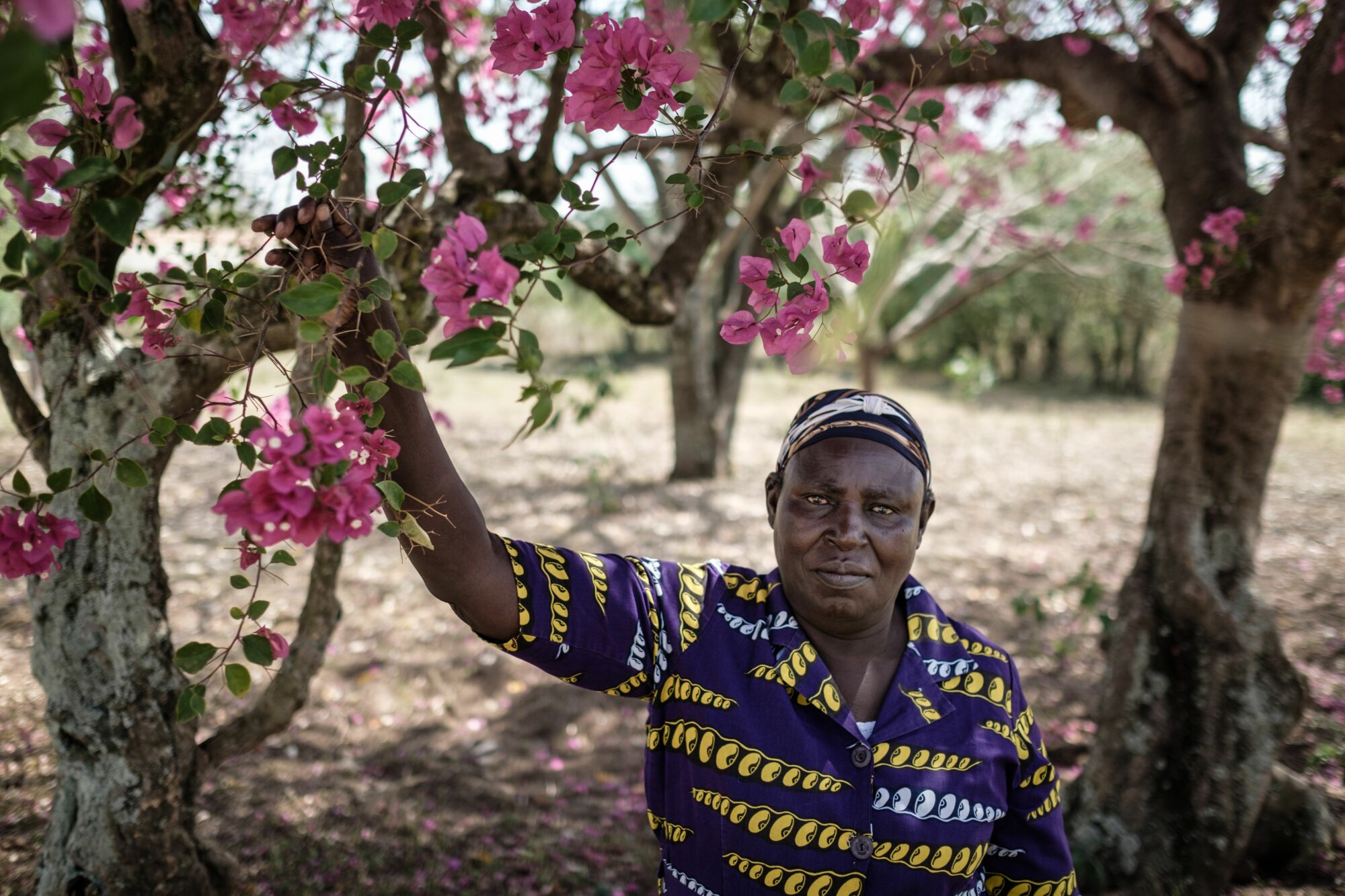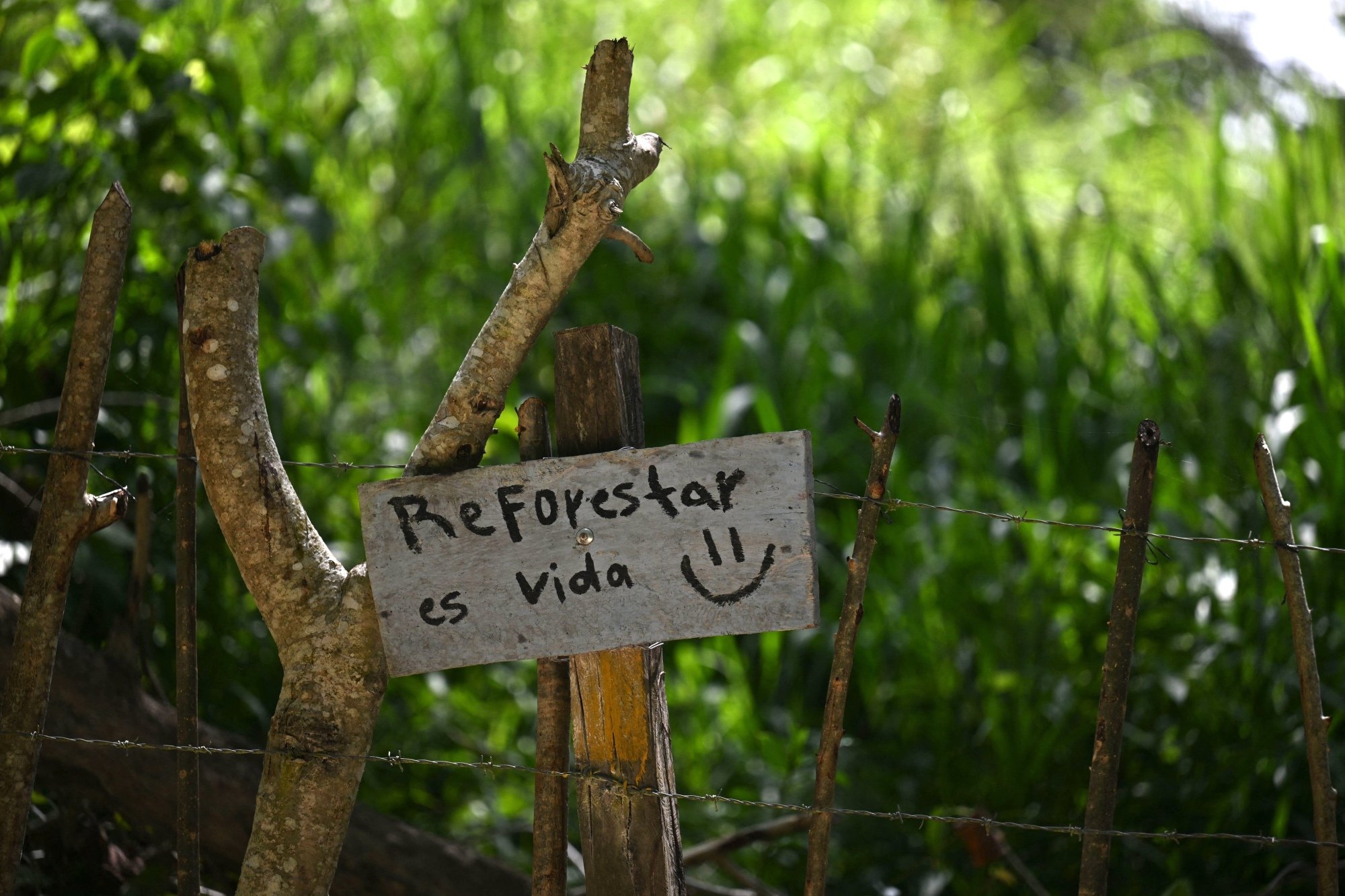24 good things already happening in 2024

By the time 2024 dawned, looking at headlines had become a grimly emotive experience. War and conquest, death and famine: the four horsemen are all back and stalking Ukraine and the Holy Land like they never left. It’s the apocalyptic reunion tour the planet never asked for, with a fifth horseman — disinformation — billed as the warm-up act.
But apart from that, Mrs. Lincoln, how do you like the play? Our entire human drama still has plenty of inspired, uplifting patches of light in it. Too much focus on daily headlines can obscure that. For example, you may not have heard anything good in the news on climate change lately: the COP28 summit was criticized as being “grossly insufficient” for the scale of this global crisis.
Ironically, though, focusing on one conference is like looking at the weather … not the climate. In 2024, cause for hope that we will limit the rate of our warming planet has never been more realistic. Here we present the reasons, plus many more positive trends kicking in as the year ticks over. Hopefully, they’re all harbingers.
Four horsemen, meet the 24 horsemen.
1. Solar power is smashing all records.
It’s official: the human race is hooked on clean, green, solar energy. The capacity of new installations in 2023 hit 413 GW by year’s end, according to a preliminary Bloomberg analysis. To give you some idea of how big that is, last year’s version of this story trumpeted the installation of 295 GW in 2022 — itself a 45 percent increase on 2021’s total — and projected 319 GW for 2023.
Turns out we overshot. Installations grew by 58 percent, meaning that even the most optimistic industry analysts are scrambling to update their models. If this exponential growth of installed panels keeps going, we could double the entire solar capacity of the planet in 2024 alone.
This is happening because the cost of solar power installation is plummeting. Polysilicon, the raw material that makes panels, is cheaper by 70 percent now than it was a year ago. In the U.S., a generous federal tax credit is slicing 30 percent off installation costs. Globally, some analysts are predicting the cost of new installations will drop to 10 cents for every watt of capacity this year — something that wasn’t supposed to happen until 2030.
2. China’s carbon emissions should go into decline this year.
A good chunk of all that renewable power was being built where it can do the most good — in China, the world’s largest emitter of greenhouse gases. China built 300 GW of solar and wind power in 2023, far more than any other country; it committed to installing 1,200 GW by 2030 and looks set to hit the target by 2025 or earlier.
It had better, because the country also has more coal plants (and more plans to build coal plants) than any other. The breakneck rise of solar and wind is starting to make those plants look obsolete, however, and that could bring the country to a tipping point. The international Center for Research on Energy and Clean Air (CREA) says current economic conditions “all but guarantee” a decline in carbon emissions in 2024 — and that if that happens, fossil fuel power in China will go into “structural decline” from which it will never recover.
Again, that wasn’t supposed to happen until 2030. Seeing a trend here? Despite the doom and gloom on climate change, we’re about six years ahead of schedule on arresting one of its leading causes.
3. Other big polluters are kicking the carbon habit too.
Overall, the planet is on course to see its first emissions drop, outside of the pandemic, in 2024. Whom else other than China should we thank? First, let’s hear it for Australia, one of the world’s top five exporters of coal, where rooftop solar is now providing more of the country’s power than that nasty little fossil fuel. With luck, a little structural decline will set in over the whole industry: keep it in the ground, down under.
The EU was largely dependent on oil and gas from Russia until 2022, when Russia invaded Ukraine. In 2023, Europe fought back against the fossil fuel-rich rogue state with massive investments in renewables and heat pumps. Now it’s reaping the rewards: a decline in CO2 emissions of roughly 2 percent a year, soon to be accelerated by a steep reduction in the carbon credits available to EU polluters in 2024.
4. Yes, Virginia, the U.S. is going green too.
The U.S. did a little better than Europe last year, in that carbon emissions dropped by three percent (again, driven by a drop in coal consumption). That’s not where the U.S. government needs to be to meet its Paris climate agreement goals; we need more like six-percent-per-year drops to keep temperatures from climbing even further. But it is a decline that happened alongside economic growth — something we weren’t sure could happen. And it too is accelerating (the drop was 2.5 percent in the first three quarters of the year).
This is the year we should see the infrastructure funded by the Inflation Reduction Act, America’s largest ever piece of climate legislation, start to make a dent in emissions numbers for the first time. Meanwhile, 12 states have now passed laws that require a transition to 100 percent clean electricity. In California, one of the worst emitters, two thirds of energy sold across the state in 2024 is set to be carbon-free.
5. The U.S. oil industry just agreed to stop emitting its most harmful gas.
The general lack of progress at the COP28 climate summit in December may have eclipsed this news, but don’t sleep on the fact that the Biden Administration just started cracking down on the most damaging greenhouse gas molecule, methane. The major players of the oil and natural gas industries have agreed to tough standards designed to slash emissions by 80 percent or 90 percent in the next six years, with annual international assessments beginning in … 2024.
6. EVs are taking off …
OK, so power generation is getting way cleaner in 2024. What about transportation, the second leading cause of CO2 emissions? Good news here too. Forget any misleading articles you might have read about electric vehicle sales slowing down; overall, globally, the number of EVs sold rose by 36 percent in 2023.
Again, the U.S. is catching up nicely, with an EV sales bump of 50 percent last year. And in 2024, when more than 40 kinds of EV will be available in American dealerships for the first time, many of them qualifying for a generous federal tax credit, that growth shows no signs of stopping.
China, meanwhile, looks likely to reach a tipping point this year where half of all cars sold will be electric (again, years ahead of schedule). That is in large part thanks to the success of BYD, a low-cost EV maker that is now outpacing Tesla. BYD’s Seagull EV costs just $ 12,000, and the company is churning out so many — a record 200,000 in one year — that BYD is spreading its seagull gospel to the vast new car markets of India and Brazil sometime this year.
7. … as are electric planes.

The global transition away from fossil fuels is happening in the heavens as well as on Earth. The Paris Olympics this July will showcase Volocopter, the world’s first fully functioning electric air taxi service. Five “Vertiports” are under construction for the drone-like two-seater vehicles. It’s not just an Olympic summer trend; some 1,900 flights are expected by years’ end. Meanwhile, another European electric plane maker, Lilium, plans to challenge Volocopter’s rotor-based system with a battery-powered jet design.
8. Batteries are about to get exponentially better.
Two things that would supercharge both the EV and the electric plane markets: a major expansion in battery capacity, and a massive reduction in charging time. Luckily, one technology that marries both is on the way.
Expect 2024 to be the year of the solid-state EV battery, a quantum leap ahead of regular old lithium-ion. Solid state boasts 40 percent more energy density, not to mention, ahem, a much reduced chance of catching fire.
The race is on to deliver the first one to the EV market. Toyota is working on a solid-state battery with a range of 900 miles, almost double the current record, which would be enough to get you from New York to Chicago without stopping. Better yet, the company says, you can charge it up in just 10 minutes. One expert calls the Toyota prototype “the holy grail of battery vehicles.”
Toyota’s tentative release date is 2025, but that may be accelerated by news that Schaeffer, one of its suppliers, is showing off a solid-state battery of its own at CES 2024. Volkswagen and Mercedes are racing to release their own solid states. And as ever, there’s a Silicon Valley upstart in the mix: QuantumScape, which just demonstrated a solid-state battery that can go from zero to 80 percent capacity in 15 minutes.
Tesla isn’t officially in this race yet – but as of 2024, Tesla’s 15,000 supercharger stations are opening up to non-Tesla vehicles (in some cases via an adapter). That means Elon Musk’s company will start inadvertently assisting its bigger-battery rivals.
9. We’ve got all the raw materials we need for the clean energy transition.
OK, but what about all the supposedly rare earth metals we need for all these EVs and batteries? We’ve got that figured out too. The prices of nickel, cobalt and lithium are plummeting as new extraction methods come online. We’ve got more than we need for current EV growth, and new reports say we can get to net zero without exhausting more than a third of the world’s supply of these metals. So stop feeling guilty about that EV, and start thinking about what else the world can create with its coming surplus of solar electricity.
10. The U.S. economy is bouncing back.
Hey, remember that recession that almost every economic expert predicted would start before 2024? It’s now viewed as unlikely, if not impossible. Stronger than expected holiday sales are raising estimates for the new year. Bloomberg now predicts GDP growth, not decline, of 2.8 percent in 2024. In our age of war and instability, when the global economy in general is feeling creaky, that’s no mean feat.
11. Inflation is actually under control, for now.
The U.S. Federal Reserve has set a target of two percent inflation by the end of 2024. Most economists now agree we’ll hit or even come in below that target. The Fed is so optimistic that it’s signaling it will cut interest rates up to three times in 2024: good news for those of us with loans and mortgages. And, given the positive reaction of the stock market so far, good news for retirement plans too.
12. Salaries are rising in real terms.
Good news also for those of us with wage packets: 2024 is set to be the first year since 2021 in which wages grow faster than inflation. In the middle of last year, economists thought it might take until the fourth quarter of 2024 for this tipping point to be reached; in fact, we arrived there when the economists were making their doom and gloom predictions.
What did happen in January 2024, though, is that the minimum wage was raised in 20 states. A majority of the U.S. now offers a minimum wage higher than the $ 7.25 federal minimum wage (unchanged since 2009), while eight states will guarantee more than double the U.S. minimum. It isn’t anywhere close to the social safety net we need, but again, here’s proof we have more than enough cash sloshing around the system to reward its poorest workers while still growing the economy.
13. The world’s largest, longest Basic Income experiment is yielding results.

Speaking of social safety nets, remember Universal Basic Income? The idea of the government just giving a living wage to everyone, no matter what their means, instead of complex bureaucratic welfare payments? It was all the rage during the pandemic, and hey, it’s not like automation became less of a threat to jobs in the past few years. Proponents point to small-scale experiments, which seem to show people spend their handouts wisely.
But there’s no experiment as large as the one run by GiveDirectly, a nonprofit that has been giving around $ 20 a month to 6,000 people in one Kenyan village since 2016, and will continue to do so until 2028. Researchers just released their first tentative results — and it turns out if you give people the money as a lump sum, rather than monthly, they don’t waste it. They spend more money on starting small businesses, or educating themselves. Now can we start seeing UBI as an investment in people rather than a handout?
14. We may be turning the tide on the obesity epidemic.
Effective weight loss injections, as Ozempic and Wegovy appear to be, aren’t just a matter of TikTok trends. For the two in five Americans who are clinically obese — a condition linked to a greater chance of dying from diabetes and cardiovascular disease among other things — a treatment that curbs your hunger could add many years to your life. Not to mention helping to unburden our overworked healthcare system.
In 2024, the weight loss treatment boom will ramp up significantly. Get ready for a third injection that sounds like a superhero/villain: Zepbound, from Eli Lily. We need to do a better job of improving access; making sure all insurance companies cover them is a good start. And we certainly need to be cautious about the side effects. But obesity is the second largest cause of preventable deaths in the world, after smoking. It kills nearly 3 million humans a year. If injections like these work, you can’t put a price tag on saving that many lives.
15. We’ve got a bunch of other diseases on the run.
Three cheers for the malaria vaccine, our best shot in the war against a disease that kills more than 500,000 children every year. The World Health Organization started distributing one in Africa last year, and just approved another, cheaper version that is rolling out as you read this.
And that’s just one of dozens of public health success stories breaking out around the planet. Polio (yes, it’s still a thing) is one step closer to total eradication now that even the Taliban has joined the fight against it in Afghanistan. Tuberculosis, still the planet’s deadliest infection, is on borrowed time thanks to a new vaccine and a new cheap generic drug. AIDS infections have fallen to levels not seen since the 1980s.
And then there’s CRISPR, the gene editing tool that is currently in its first year of treating sickle cell disease, but setting its sights much higher. Its inventor now hopes to cure asthma via subtle changes to bacteria in your gut.
16. Extreme poverty is on the way out again.
As we noted in 2020, the COVID-19 pandemic put an end to decades of progress on extreme poverty (which the World Bank now defines as living on less than $ 2.15 a day). We’re still not on track to meet the U.N.’s sustainable development goal, that of eradicating extreme poverty by 2030. But the economy did start trending in the right direction again in 2023, with India and most countries in southeast Asia pulling their poorest out of the tailspin.
If you want a shot of hope in 2024, go look at the World Poverty Clock website. At time of writing this visualization tool a net 7,000 stick figures running away from the $ 2.15 line every day — and gives the total number of extreme poor people in the world at under 630 million, or more than 80 million less than at the most depressing moment of 2020.
17. Two words: Fewer. Plastics.
Good news for those of us who groan at the thought of the Great Pacific Garbage Patch: it, along with all the collections of debris in our ocean, is smaller than we thought. A major study last year estimated that half a million metric tons of plastic ends up in our seas every year – which isn’t great, but it’s also 7.5 million tons below the previous estimate.
More importantly, the war on plastic waste is gearing up. A hundred countries now ban plastics in some form. The EU just banned export of plastic waste, forcing its members to deal with the problem themselves instead of farming it out to poorer countries.
By June 2024, the EU is also required to finish what’s known as the Packaging and Packaging Waste Regulation. Despite a name only a bureaucrat could love, this is the world’s biggest attempt yet to crack down on microplastics leaking into the environment, and it’s shaping up to be a doozy. Some kinds of packaging will just be outright banned. All packaging must contain recycled material by 2030, and be recycled “at scale” by 2035. Your move, U.S. and China.
18. The Amazon rainforest is less threatened.
The world’s lungs started 2024 … well, not quite breathing easier, but close. Under Brazil’s new eco-minded president Lula, deforestation in the Amazon is at the lowest level it’s been in five years; under his predecessor, it was at its highest level in 15 years. Lula just announced a $ 204 million reforestation fund, and aims to end all illegal burns by 2030. We’ll get a better look at the situation on the ground across the Amazon this summer, when Brazil’s space agency releases a full report based on satellite data.
18. More lands and waters are being preserved and restored …

It isn’t just the Amazon. We’re preserving forests all over the world (like Alaska’s newly protected Tongass National Forest) and creating new ones – as in Africa, where reforestation efforts have created a stunning 400,000 square kilometers of new growth; just this year, Mali is aiming to fill 40,000 square kilometers more.
Same goes for our waterways. Some 44 countries just joined in a massive effort called the Freshwater Challenge, which aims to restore 300,000 square km of rivers by 2030 along with 350 million hectares of wetlands.
And in February 2024, the EU (yeah, them again) will finally rubber-stamp a historic, ambitious Nature Restoration Law, after two years of wrangling. Member states agreed to restore 30 percent of listed habitats to “good condition” (defined by neutral inspections) by 2030, then 60 percent by 2040, and 90 percent by 2050. Better get cracking.
19. … as are more species.
Though over 1,500 endangered or threatened species remain on the Fish and Wildlife Service’s list, it’s worth perusing the formerly endangered species that have recently joined the recovery list thanks to painstaking conservation efforts. Try to think of a more iconic bunch. There’s the African lion and elephant, the American bison and Bald eagle, the blue whale and the humpback whale, the monarch butterfly, the mountain gorilla, the grey wolf, the sea otter, the snow leopard. No word yet on whether the conservationists and their ever-improving tech can actually get a species of phoenix to rise from flames, but no doubt they’ll give it a go once they’ve saved all the others.
20. Crime keeps coming down … as more prisoners go free.
The U.S. started its new year safer than it has been this century, even if it didn’t feel that way. Murder was down by roughly 13 percent in 2023, according to preliminary figures, which will if confirmed be one of the largest one-year drops ever. Violent crime and property crime are both down to 1960s levels.
Oh, and look what else is happening: the prison population is in a long slow decline since 2011. It’s almost like the prison-industrial complex wasn’t keeping us safe in the first place! The prisons may empty a little more once thousands of people convicted for using cannabis on federal lands apply for their pardons, as the Biden Administration announced in December.
21. AI is actually being useful.
If 2023 was all about AI hype and AI-generated content of varying usefulness and controversy, then 2024 may be the year the unseen algorithms settle down and start finding new useful – if slightly more pedestrian – things to do.
One great example is Google’s Project Green Light, unveiled in Jan. 2024. The company is working with cities around the world, using its AI to … time traffic lights for more effective traffic flow. According to Google, that could reduce overall levels of stop-and-go traffic by 30 percent — which should be one small step for the environment, and one giant chill pill for road rage.
22. Abortion rights are winning everywhere.
You probably noticed the political ground shift after the Supreme Court overturned Roe v. Wade in 2022. Reproductive rights are winning election after election, and abortion is officially now protected or expanded in 17 states. Petitions for further ballot measures are now out there in 11 states, so the 2024 election situation is wide open. Campaigners can be buoyed by the recent victory in Mexico, where a more enlightened Supreme Court recently declared – unanimously! – that penalizing any woman, pregnant person, or health worker over abortion is unconstitutional.
23. LGBTQ rights are winning (mostly) everywhere.
It can be easy to miss the ongoing patchwork success of expanding legalized marriage. But if you wanted to book a same-sex wedding in Bulgaria, Estonia, Peru, Hong Kong, Romania or Thailand, well, 2024 is the first full calendar year in which you can. Look for the ground to shift further and wider this year, now that Pope Francis has given his blessing to priests blessing same-sex couples — a godsend for marriage rights activists in many Catholic countries.
Meanwhile, transgender rights legislation has recently succeeded in Germany, Spain and Finland. And even if 2023 was also a banner year for anti-trans legislation in the U.S., there are several pro-trans initiatives on the ballot in several states in 2024.
24. The largest experiment in democracy is about to begin.
Thanks to the collision of several electoral calendars, the sheer number of human beings heading to the polls in 2024 will very likely make it the most democratic (if not necessarily Democratic) year in history. It’s not just the U.S., it’s also the UK, the European Union, India, South Africa, Mexico, and Taiwan. (Let’s not insult anyone’s intelligence by including the Russian presidential elections, though millions will be heading to the Putin polls there too.)
It’s also shaping up to be the most consequential year of ballots in history. The result in Taiwan, where pro- and anti-China parties are squaring off, could hasten a long-feared invasion that might lead to a U.S.-China war. Modi may consolidate his Hindu nationalist grip on India, and then go head to head with a new Pakistani president. The UK’s Conservative party may be annihilated for a generation, if the last year of polls are to be believed.
And apparently the U.S. election might end democracy in America, or save it for another generation, or something like that?
All of which might not be the lightest note to end on, but here’s what we need to remember: none of these elections are foregone conclusions. This is absolutely all in the balance. No outcome is set in stone. Everything depends … well, on you, dear readers with votes. We hope you are more encouraged to use them now. Because if there’s one thing 2024 and this list has proved so far, it’s that there is most definitely a chance in hell.


